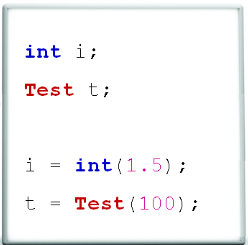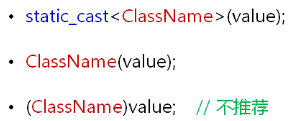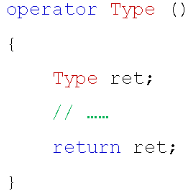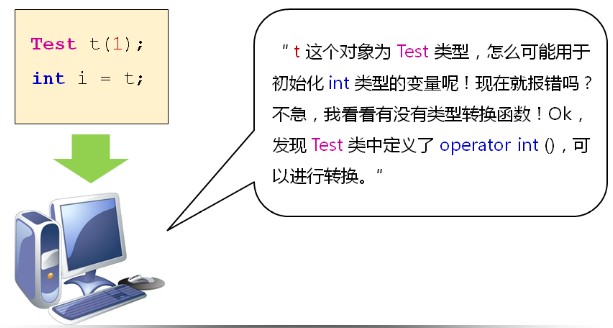C++解析(20):智慧指標與型別轉換函式
阿新 • • 發佈:2018-12-08
0.目錄
1.智慧指標
2.轉換建構函式
3.型別轉換函式
4.小結
1.智慧指標
記憶體洩漏(臭名昭著的Bug):
- 動態申請堆空間,用完後不歸還
- C++語言中沒有垃圾回收機制
- 指標無法控制所指堆空間的生命週期
我們需要什麼:
- 需要一個特殊的指標
- 指標生命週期結束時主動釋放堆空間
- 一片堆空間最多隻能由一個指標標識
- 杜絕指標運算和指標比較
解決方案:
- 過載指標特徵操作符( -> 和 * )
- 只能通過類的成員函式過載
- 過載函式不能使用引數
- 只能定義一個過載函式
示例——實現智慧指標:
#include <iostream> #include <string> using namespace std; class Test { int i; public: Test(int i) { cout << "Test(int i)" << endl; this->i = i; } int value() { return i; } ~Test() { cout << "~Test()" << endl; } }; class Pointer { Test* mp; public: Pointer(Test* p = NULL) { mp = p; } Pointer(const Pointer& obj) { mp = obj.mp; const_cast<Pointer&>(obj).mp = NULL; } Pointer& operator = (const Pointer& obj) { if( this != &obj ) { delete mp; mp = obj.mp; const_cast<Pointer&>(obj).mp = NULL; } return *this; } Test* operator -> () { return mp; } Test& operator * () { return *mp; } bool isNull() { return (mp == NULL); } ~Pointer() { delete mp; } }; int main() { Pointer p1 = new Test(3); cout << p1->value() << endl; Pointer p2 = p1; cout << p1.isNull() << endl; cout << p2->value() << endl; return 0; }
執行結果為:
[[email protected] Desktop]# g++ test.cpp
[[email protected] Desktop]# ./a.out
Test(int i)
3
1
3
~Test()智慧指標的使用軍規——只能用來指向堆空間中的物件或者變數
2.轉換建構函式
再論型別轉換:
C語言標準資料型別之間會進行隱式的型別安全轉換
C語言轉換規則如下:

(C語言編譯器支援從小型別(佔用記憶體少)轉換到大型別(佔用記憶體多)的隱式型別轉換,因為這樣的轉換是安全的,不會發生資料截斷或者資料丟失。)
示例——隱式型別轉換的bug:
#include <iostream> #include <string> using namespace std; int main() { short s = 'a'; unsigned int ui = 1000; int i = -2000; double d = i; cout << "d = " << d << endl; cout << "ui = " << ui << endl; cout << "ui + i = " << ui + i << endl; if( (ui + i) > 0 ) { cout << "Positive" << endl; } else { cout << "Negative" << endl; } cout << "sizeof(s + 'b') = " << sizeof(s + 'b') << endl; return 0; }
執行結果為:
[[email protected] Desktop]# g++ test.cpp
[[email protected] Desktop]# ./a.out
d = -2000
ui = 1000
ui + i = 4294966296
Positive
sizeof(s + 'b') = 4(在大多數編譯器看來,int型別,也就是4個位元組的整型數的運算是最高效的。而在sizeof(s + 'b')中,是做加法運算,左運算元和右運算元都可以安全的轉換為int,那麼可以採用更高效的方式來進行運算。於是就出現bug了!)
問題:
普通型別與類型別之間能否進行型別轉換
類型別之間能否進行型別轉換?
再論建構函式:
- 建構函式可以定義不同型別的引數
- 引數滿足下列條件時稱為轉換建構函式
- 有且僅有一個引數
- 引數是基本型別
- 引數是其它類型別
舊式的C方式強制型別轉換:

編譯器會盡力嘗試讓原始碼通過編譯(普通型別->類型別):

示例——編譯器自作聰明的行為:
#include <iostream>
#include <string>
using namespace std;
class Test
{
int mValue;
public:
Test() { mValue = 0; }
Test(int i) { mValue = i; }
Test operator + (const Test& p)
{
Test ret(mValue + p.mValue);
return ret;
}
int value() { return mValue; }
};
int main()
{
Test t;
t = 5; // t = Test(5);
Test r;
r = t + 10; // r = t + Test(10);
cout << r.value() << endl;
return 0;
}執行結果為:
[[email protected] Desktop]# g++ test.cpp
[[email protected] Desktop]# ./a.out
15編譯器盡力嘗試的結果是隱式型別轉換。
隱式型別轉換:
- 會讓程式以意想不到的方式進行工作
- 是工程中bug的重要來源
工程中通過explicit關鍵字杜絕編譯器的轉換嘗試
轉換建構函式被explicit修飾時只能進行顯示轉換
轉換方式:

示例——杜絕編譯器的轉換嘗試:
#include <iostream>
#include <string>
using namespace std;
class Test
{
int mValue;
public:
Test() { mValue = 0; }
explicit Test(int i) { mValue = i; }
Test operator + (const Test& p)
{
Test ret(mValue + p.mValue);
return ret;
}
int value() { return mValue; }
};
int main()
{
Test t;
t = static_cast<Test>(5); // t = Test(5);
Test r;
r = t + static_cast<Test>(10); // r = t + Test(10);
cout << r.value() << endl;
return 0;
}執行結果為:
[[email protected] Desktop]# g++ test.cpp
[[email protected] Desktop]# ./a.out
153.型別轉換函式
問題:
類型別是否能夠型別轉換到普通型別?
型別轉換函式:
- C++類中可以定義型別轉換函式
- 型別轉換函式用於將類物件轉換為其它型別
- 語法規則:

示例——只有想不到,沒有做不到:
#include <iostream>
using namespace std;
class Test
{
int mValue;
public:
Test(int i = 0) { mValue = i; }
operator int() { return mValue; }
};
int main()
{
Test t(100);
int i = t; // ==> t.operator int()
cout << "i = " << i << endl;
return 0;
}執行結果為:
[[email protected] Desktop]# g++ test.cpp
[[email protected] Desktop]# ./a.out
i = 100型別轉換函式:
- 與轉換建構函式具有同等的地位
- 使得編譯器有能力將物件轉化為其它型別
- 編譯器能夠隱式的使用型別轉換函式
編譯器會盡力嘗試讓原始碼通過編譯:

型別轉換函式 vs 轉換建構函式:
- 無法抑制隱式的型別轉換函式呼叫
- 型別轉換函式可能與轉換建構函式衝突
- 工程中以Type toType()的公有成員代替型別轉換函式
示例——能通過編譯的型別轉換函式:
#include <iostream>
#include <string>
using namespace std;
class Test;
class Value
{
public:
Value() {}
};
class Test
{
int mValue;
public:
Test(int i = 0) { mValue = i; }
int value() { return mValue; }
operator Value()
{
Value ret;
cout << "operator Value()" << endl;
return ret;
}
};
int main()
{
Test t(100);
Value v = t; // ==> t.operator Value()
return 0;
}示例——能通過編譯的轉換建構函式:
#include <iostream>
#include <string>
using namespace std;
class Test;
class Value
{
public:
Value() {}
Value(Test& t) {}
};
class Test
{
int mValue;
public:
Test(int i = 0) { mValue = i; }
int value() { return mValue; }
};
int main()
{
Test t(100);
Value v = t; // ==> Value(t)
return 0;
}示例——衝突的型別轉換函式與轉換建構函式:
#include <iostream>
#include <string>
using namespace std;
class Test;
class Value
{
public:
Value() {}
Value(Test& t) {}
};
class Test
{
int mValue;
public:
Test(int i = 0) { mValue = i; }
int value() { return mValue; }
operator Value()
{
Value ret;
cout << "operator Value()" << endl;
return ret;
}
};
int main()
{
Test t(100);
Value v = t;
return 0;
}報錯資訊為:
[[email protected] Desktop]# g++ test.cpp
test.cpp: In function ‘int main()’:
test.cpp:32: error: conversion from ‘Test’ to ‘Value’ is ambiguous
test.cpp:21: note: candidates are: Test::operator Value()
test.cpp:12: note: Value::Value(Test&)示例——使用explicit關鍵字避免衝突:
#include <iostream>
#include <string>
using namespace std;
class Test;
class Value
{
public:
Value() {}
explicit Value(Test& t) {}
};
class Test
{
int mValue;
public:
Test(int i = 0) { mValue = i; }
int value() { return mValue; }
operator Value()
{
Value ret;
cout << "operator Value()" << endl;
return ret;
}
};
int main()
{
Test t(100);
Value v = t;
return 0;
}4.小結
- 指標特徵操作符( -> 和 * )可以被過載
- 過載指標特徵符能夠使用物件代替指標
- 智慧指標只能用於指向堆空間中的記憶體
- 智慧指標的意義在於最大程度的避免記憶體問題
- 轉換建構函式只有一個引數
- 轉換建構函式的引數型別是其它型別
- 轉換建構函式在型別轉換時被呼叫
- 隱式型別轉換是I程中bug的重要來源
- explicit關鍵字用於杜絕隱式型別轉換
- C++類中可以定義型別轉換函式
- 型別轉換函式用於將類物件轉換為其它型別
- 型別轉換函式與轉換建構函式具有同等的地位
- 工程中以Type toType()的公有成員代替型別轉換函式
